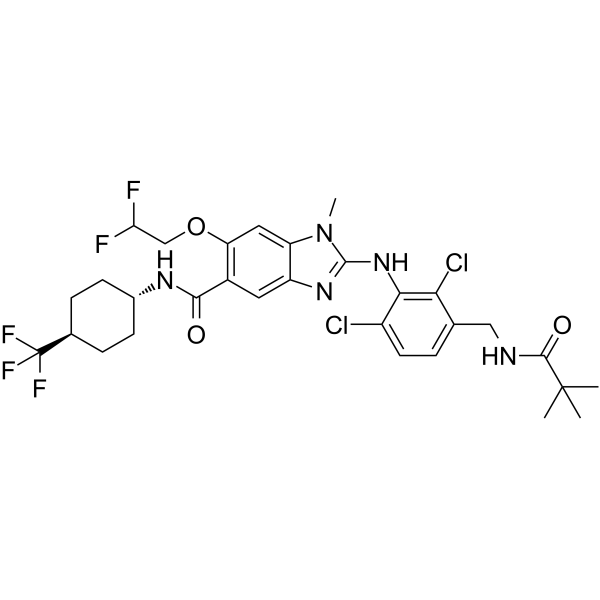Vipoglanstat
Modify Date: 2025-08-27 12:47:44

Vipoglanstat structure
|
Common Name | Vipoglanstat | ||
|---|---|---|---|---|
| CAS Number | 1360622-01-0 | Molecular Weight | 678.52 | |
| Density | N/A | Boiling Point | N/A | |
| Molecular Formula | C30H34Cl2F5N5O3 | Melting Point | N/A | |
| MSDS | N/A | Flash Point | N/A | |
Use of VipoglanstatVipoglanstat (BI 1029539, GS-248), a carboxamide, is a potent and selective, non-peptide and orally active small molecular inhibitor of human prostaglandin E synthase 1 (mPGES-1). Vipoglanstat (BI 1029539, GS-248) also has anti-inflammatory activity[1][2]. |
| Name | Vipoglanstat |
|---|
| Description | Vipoglanstat (BI 1029539, GS-248), a carboxamide, is a potent and selective, non-peptide and orally active small molecular inhibitor of human prostaglandin E synthase 1 (mPGES-1). Vipoglanstat (BI 1029539, GS-248) also has anti-inflammatory activity[1][2]. |
|---|---|
| Related Catalog | |
| In Vitro | Vipoglanstat (BI 1029539, GS-248) significantly inhibits mPGES-1 level (IC50: about 1 nM) in isolated brain capillaries from transgenic human-mPGES-1 mice. Vipoglanstat (BI 1029539, GS-248) blocks the up-regulation of P-gp and mPGES-1 levels on glutamate-mediatedin isolated brain capillaries. Vipoglanstat (BI 1029539, GS-248) reduces human peripheral blood inflammatory cell migration and inflammatory mediator release[3]. |
| In Vivo | Vipoglanstat (BI 1029539, GS-248) (30 mg/kg; i.p.) can reduce LPS-induced lung injury, with reduction in neutrophil influx, protein content, TNF-ɑ, IL-1β and PGE2 levels in bronchoalveolar lavage (BAL), myeloperoxidase activity, expression of mPGES-1, cyclooxygenase (COX)-2 and intracellular adhesion molecule in lung tissue. Vipoglanstat (BI 1029539, GS-248) (30 mg/kg; p.o.; 2 hrs, 8 hrs and 22 hrs) significantly reduces sepsis-induced BAL inflammatory cell recruitment, lung injury score and lung expression of mPGES-1 and inducible nitric oxide synthase. Vipoglanstat (BI 1029539, GS-248) (30 mg/kg; p.o.; QD) also significantly prolongs survival of mice with severe sepsis[2]. Animal Model: LPS-induced acute lung injury models[2] Dosage: 30 mg/kg Administration: 30 mg/kg, i.p. Result: Preserved lung architecture and reduced immune cell influx into the lungs of LPS‑challenged mice. Animal Model: CLP-induced sepsis models[2] Dosage: 30 mg/kg Administration: 30 mg/kg, p.o., 2 hrs, 8 hrs and 22 hrs; 30 mg/kg, p.o., QD Result: Attenuated CLP‑induced lung injury and prolongs survival. |
| References |
| Molecular Formula | C30H34Cl2F5N5O3 |
|---|---|
| Molecular Weight | 678.52 |
| InChIKey | PFORUFFGGNOLPJ-UHFFFAOYSA-N |
| SMILES | Cn1c(Nc2c(Cl)ccc(CNC(=O)C(C)(C)C)c2Cl)nc2cc(C(=O)NC3CCC(C(F)(F)F)CC3)c(OCC(F)F)cc21 |